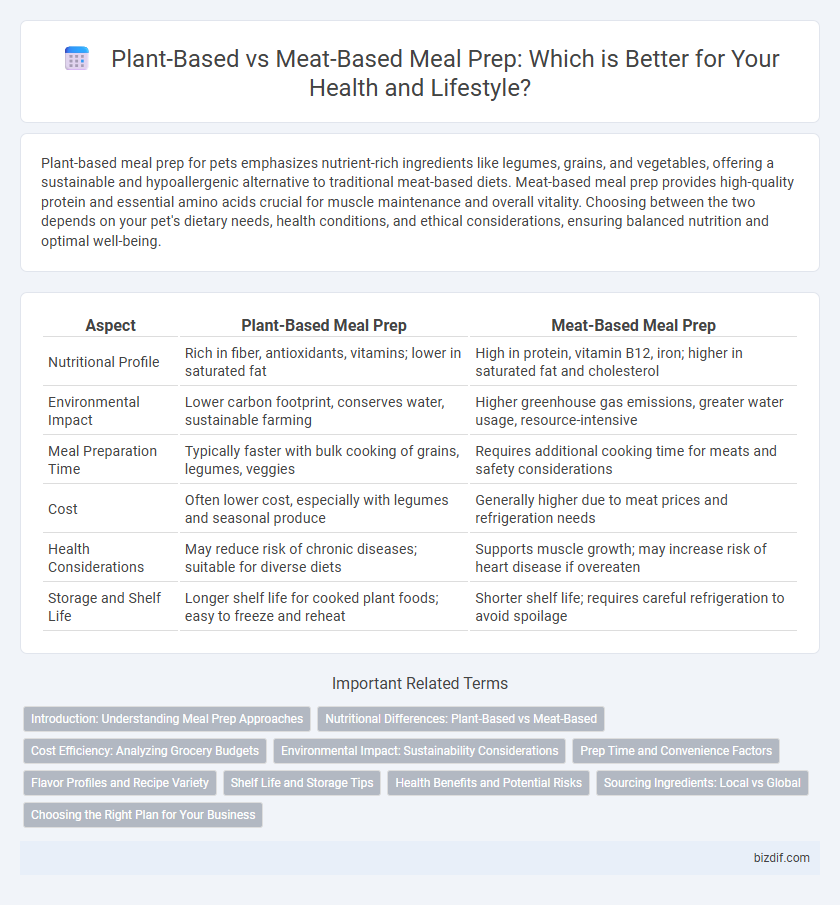Plant-based meal prep for pets emphasizes nutrient-rich ingredients like legumes, grains, and vegetables, offering a sustainable and hypoallergenic alternative to traditional meat-based diets. Meat-based meal prep provides high-quality protein and essential amino acids crucial for muscle maintenance and overall vitality. Choosing between the two depends on your pet's dietary needs, health conditions, and ethical considerations, ensuring balanced nutrition and optimal well-being.
Table of Comparison
| Aspect | Plant-Based Meal Prep | Meat-Based Meal Prep |
|---|---|---|
| Nutritional Profile | Rich in fiber, antioxidants, vitamins; lower in saturated fat | High in protein, vitamin B12, iron; higher in saturated fat and cholesterol |
| Environmental Impact | Lower carbon footprint, conserves water, sustainable farming | Higher greenhouse gas emissions, greater water usage, resource-intensive |
| Meal Preparation Time | Typically faster with bulk cooking of grains, legumes, veggies | Requires additional cooking time for meats and safety considerations |
| Cost | Often lower cost, especially with legumes and seasonal produce | Generally higher due to meat prices and refrigeration needs |
| Health Considerations | May reduce risk of chronic diseases; suitable for diverse diets | Supports muscle growth; may increase risk of heart disease if overeaten |
| Storage and Shelf Life | Longer shelf life for cooked plant foods; easy to freeze and reheat | Shorter shelf life; requires careful refrigeration to avoid spoilage |
Introduction: Understanding Meal Prep Approaches
Plant-based meal prep centers on ingredients like legumes, grains, vegetables, nuts, and seeds to create nutrient-dense, fiber-rich dishes. Meat-based meal prep emphasizes protein sources such as chicken, beef, pork, and fish, often paired with vegetables and grains for balanced meals. Understanding these distinct approaches helps tailor meal planning to dietary preferences, nutritional goals, and lifestyle needs.
Nutritional Differences: Plant-Based vs Meat-Based
Plant-based meal prep offers higher fiber content, essential vitamins like C and K, and antioxidants, supporting heart health and digestion. Meat-based meal prep provides complete proteins rich in essential amino acids, heme iron, and vitamin B12, crucial for muscle repair and oxygen transport. Balancing these nutritional differences ensures personalized dietary needs and optimized overall health.
Cost Efficiency: Analyzing Grocery Budgets
Plant-based meal prep typically reduces grocery costs due to lower prices of legumes, grains, and seasonal vegetables compared to meat products. Meat-based meal prep often incurs higher expenses from protein sources like beef, chicken, and fish, impacting weekly grocery budgets significantly. Strategic plant-based shopping and bulk purchasing can maximize savings and enhance cost efficiency in meal planning.
Environmental Impact: Sustainability Considerations
Plant-based meal prep significantly reduces greenhouse gas emissions compared to meat-based meal prep, with plant foods producing up to 90% less emissions. Sustainable plant-based diets require fewer natural resources such as water and land, aiding in biodiversity preservation and reducing deforestation. Meat-based meal prep contributes to higher environmental degradation through extensive resource use and methane emissions from livestock.
Prep Time and Convenience Factors
Plant-based meal prep typically requires less cook time due to the simplicity of ingredients like vegetables, grains, and legumes, which often cook faster than meats. Convenience factors favor plant-based meals because they generally involve fewer steps, less cleanup, and easier storage options. In contrast, meat-based meal prep demands longer cooking durations, precise temperature control, and more complex handling to ensure safety, which can increase prep time and reduce convenience.
Flavor Profiles and Recipe Variety
Plant-based meal prep offers a diverse range of flavors, from smoky chipotle to tangy tamarind, utilizing spices, herbs, and umami-rich ingredients like mushrooms and nutritional yeast to create complex taste profiles. Meat-based meal prep centers around savory, rich flavors often enhanced by marinades, rubs, and slow-cooking techniques, delivering hearty and robust dishes. Recipe variety in plant-based options includes a wide array of legumes, grains, vegetables, and meat substitutes, while meat-based recipes focus on different cuts, cooking methods, and complementary sides to maximize flavor diversity.
Shelf Life and Storage Tips
Plant-based meal prep generally offers a longer shelf life due to lower moisture content and reduced risk of bacterial growth compared to meat-based meals, which require stricter refrigeration within 3 to 4 days. Vacuum sealing vegetables and legumes can extend freshness up to 7 days, while cooked meats should be stored at or below 40degF and consumed within 3 days to prevent spoilage. Freezing both plant and meat-based meals is optimal for long-term storage, with plant-based dishes maintaining texture better and meats requiring thorough reheating to ensure food safety.
Health Benefits and Potential Risks
Plant-based meal prep offers high fiber, antioxidants, and lower saturated fat, reducing risks of heart disease, diabetes, and certain cancers. Meat-based meal prep provides rich protein, B vitamins, and iron essential for muscle growth and energy but may contribute to higher cholesterol and inflammation if consumed excessively. Balancing both approaches with diverse ingredients can maximize health benefits while minimizing potential risks.
Sourcing Ingredients: Local vs Global
Sourcing ingredients for plant-based meal prep often emphasizes local, seasonal produce to ensure freshness and reduce carbon footprint, supporting sustainable agriculture. Meat-based meal prep typically relies on a global supply chain, involving imported animal proteins that can vary in quality and environmental impact. Prioritizing local sourcing in both meal prep styles enhances ingredient traceability and nutritional value while minimizing transportation emissions.
Choosing the Right Plan for Your Business
Choosing the right meal prep plan for your business involves evaluating customer preferences and nutritional trends, where plant-based meal prep appeals to health-conscious and environmentally aware clients due to its emphasis on sustainability and nutrient density. Meat-based meal prep caters to those seeking higher protein intake and traditional flavor profiles, often requiring careful sourcing of quality animal products to maintain freshness and compliance with food safety regulations. Balancing supply chain costs, shelf life, and market demand are critical factors in determining which plan maximizes profitability and customer satisfaction.
Plant-Based Meal Prep vs Meat-Based Meal Prep Infographic

 bizdif.com
bizdif.com